Analyzing Resources for Effective Teaching and Learning Practice
VerifiedAdded on 2023/06/11
|13
|3796
|96
Report
AI Summary
This report provides a detailed analysis of teaching and learning resources, emphasizing their purpose and effectiveness in meeting diverse student needs. It evaluates specific resources within teaching and learning contexts, examining the principles of resource design and how theories of inclusive curriculum design inform resource development. The report further explores various sources that contribute to resource development, including emerging technologies, and discusses how resources can be adapted for inclusive approaches. Finally, it identifies the strengths and weaknesses in a teacher's ability to develop and utilize these resources, concluding with recommendations for improvement, and is available for students to study as an example on Desklib.
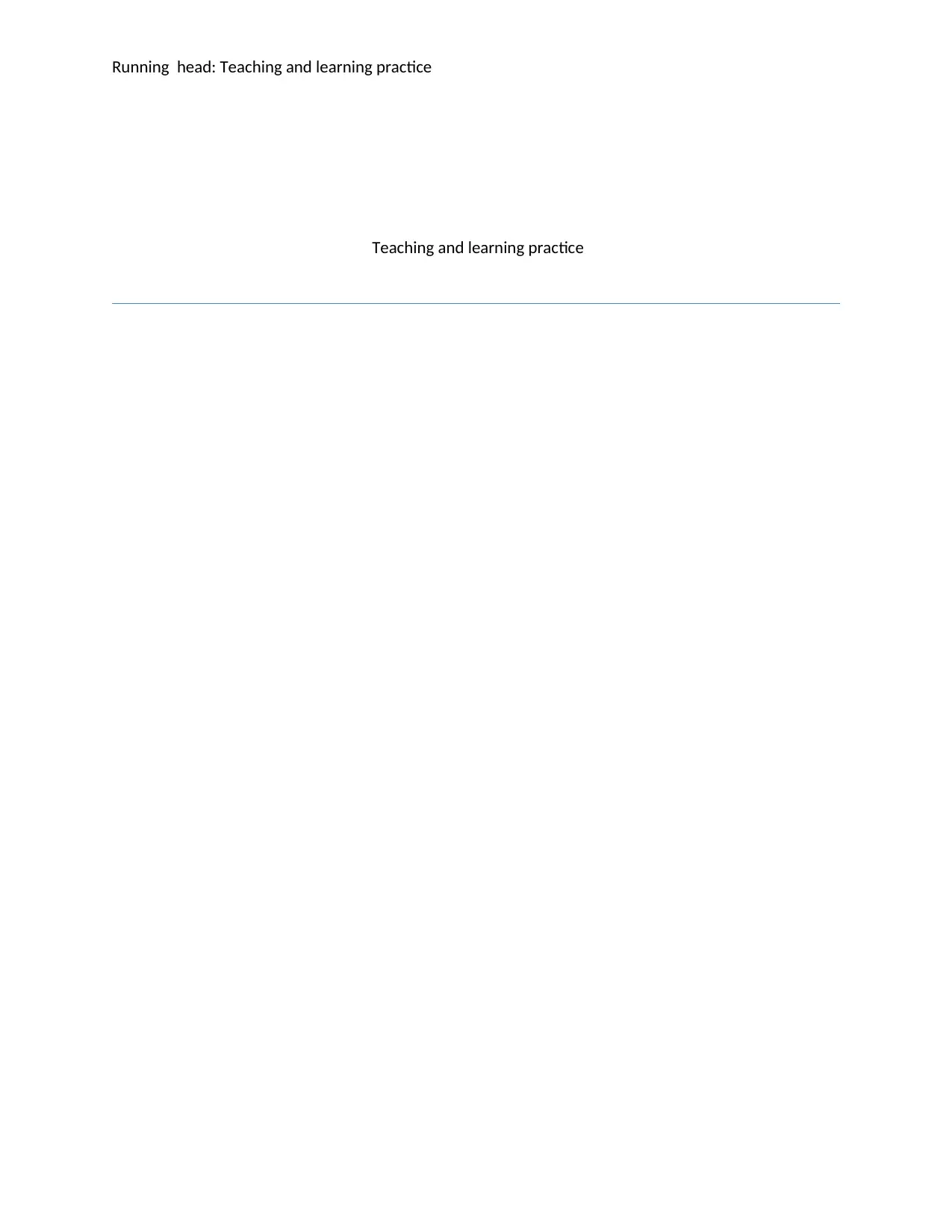
Running head: Teaching and learning practice
Teaching and learning practice
Teaching and learning practice
Paraphrase This Document
Need a fresh take? Get an instant paraphrase of this document with our AI Paraphraser
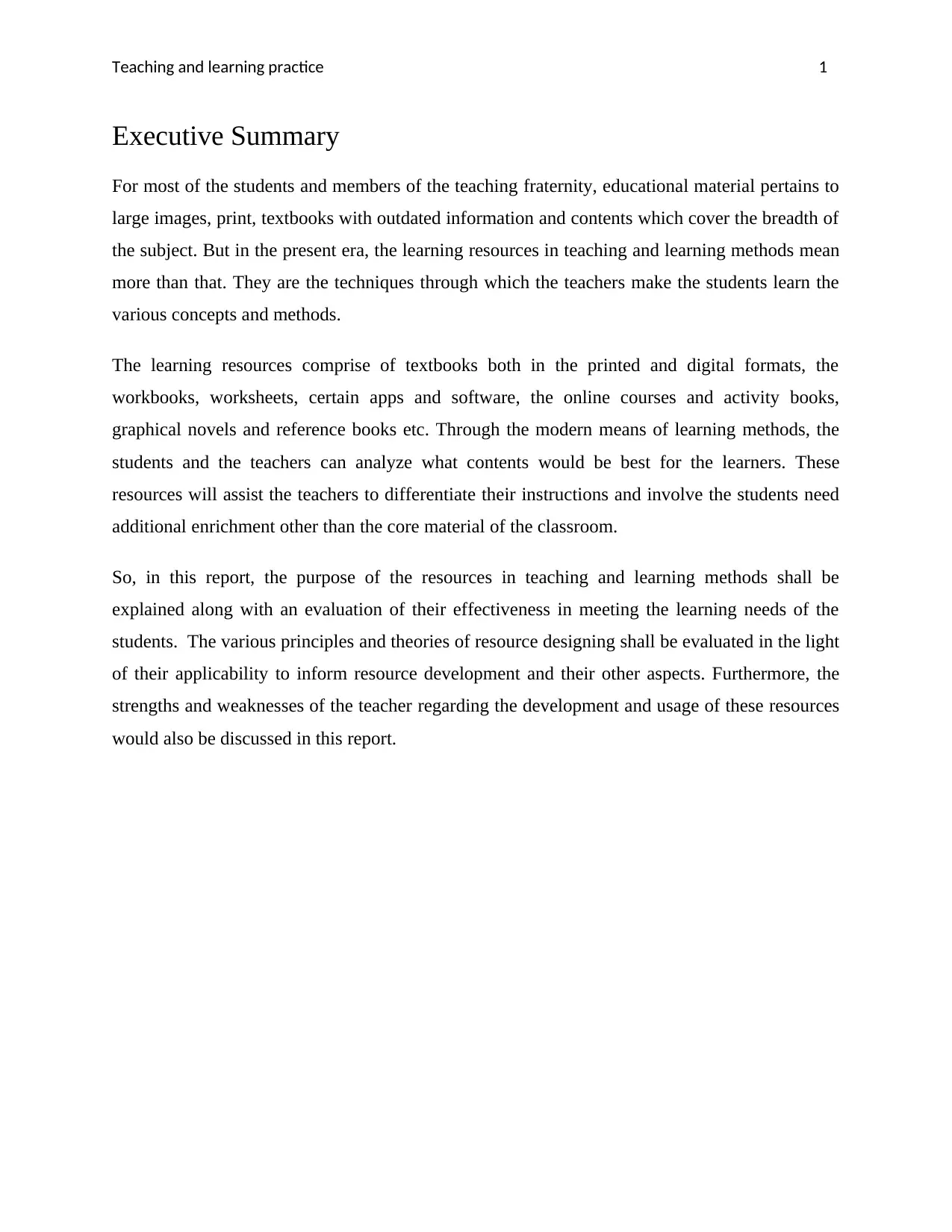
Teaching and learning practice 1
Executive Summary
For most of the students and members of the teaching fraternity, educational material pertains to
large images, print, textbooks with outdated information and contents which cover the breadth of
the subject. But in the present era, the learning resources in teaching and learning methods mean
more than that. They are the techniques through which the teachers make the students learn the
various concepts and methods.
The learning resources comprise of textbooks both in the printed and digital formats, the
workbooks, worksheets, certain apps and software, the online courses and activity books,
graphical novels and reference books etc. Through the modern means of learning methods, the
students and the teachers can analyze what contents would be best for the learners. These
resources will assist the teachers to differentiate their instructions and involve the students need
additional enrichment other than the core material of the classroom.
So, in this report, the purpose of the resources in teaching and learning methods shall be
explained along with an evaluation of their effectiveness in meeting the learning needs of the
students. The various principles and theories of resource designing shall be evaluated in the light
of their applicability to inform resource development and their other aspects. Furthermore, the
strengths and weaknesses of the teacher regarding the development and usage of these resources
would also be discussed in this report.
Executive Summary
For most of the students and members of the teaching fraternity, educational material pertains to
large images, print, textbooks with outdated information and contents which cover the breadth of
the subject. But in the present era, the learning resources in teaching and learning methods mean
more than that. They are the techniques through which the teachers make the students learn the
various concepts and methods.
The learning resources comprise of textbooks both in the printed and digital formats, the
workbooks, worksheets, certain apps and software, the online courses and activity books,
graphical novels and reference books etc. Through the modern means of learning methods, the
students and the teachers can analyze what contents would be best for the learners. These
resources will assist the teachers to differentiate their instructions and involve the students need
additional enrichment other than the core material of the classroom.
So, in this report, the purpose of the resources in teaching and learning methods shall be
explained along with an evaluation of their effectiveness in meeting the learning needs of the
students. The various principles and theories of resource designing shall be evaluated in the light
of their applicability to inform resource development and their other aspects. Furthermore, the
strengths and weaknesses of the teacher regarding the development and usage of these resources
would also be discussed in this report.
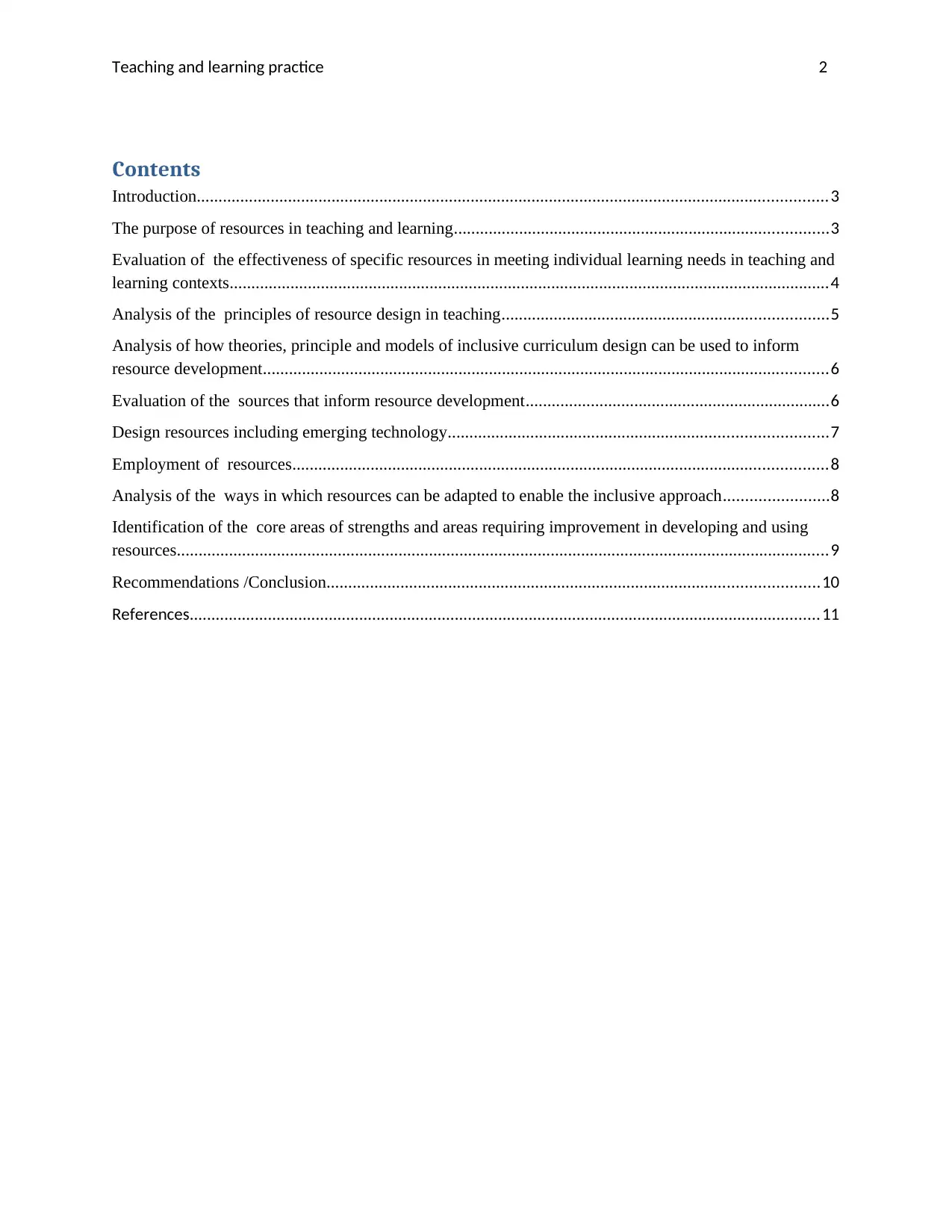
Teaching and learning practice 2
Contents
Introduction.................................................................................................................................................3
The purpose of resources in teaching and learning......................................................................................3
Evaluation of the effectiveness of specific resources in meeting individual learning needs in teaching and
learning contexts..........................................................................................................................................4
Analysis of the principles of resource design in teaching...........................................................................5
Analysis of how theories, principle and models of inclusive curriculum design can be used to inform
resource development..................................................................................................................................6
Evaluation of the sources that inform resource development......................................................................6
Design resources including emerging technology.......................................................................................7
Employment of resources...........................................................................................................................8
Analysis of the ways in which resources can be adapted to enable the inclusive approach........................8
Identification of the core areas of strengths and areas requiring improvement in developing and using
resources......................................................................................................................................................9
Recommendations /Conclusion.................................................................................................................10
References.................................................................................................................................................11
Contents
Introduction.................................................................................................................................................3
The purpose of resources in teaching and learning......................................................................................3
Evaluation of the effectiveness of specific resources in meeting individual learning needs in teaching and
learning contexts..........................................................................................................................................4
Analysis of the principles of resource design in teaching...........................................................................5
Analysis of how theories, principle and models of inclusive curriculum design can be used to inform
resource development..................................................................................................................................6
Evaluation of the sources that inform resource development......................................................................6
Design resources including emerging technology.......................................................................................7
Employment of resources...........................................................................................................................8
Analysis of the ways in which resources can be adapted to enable the inclusive approach........................8
Identification of the core areas of strengths and areas requiring improvement in developing and using
resources......................................................................................................................................................9
Recommendations /Conclusion.................................................................................................................10
References.................................................................................................................................................11
⊘ This is a preview!⊘
Do you want full access?
Subscribe today to unlock all pages.

Trusted by 1+ million students worldwide
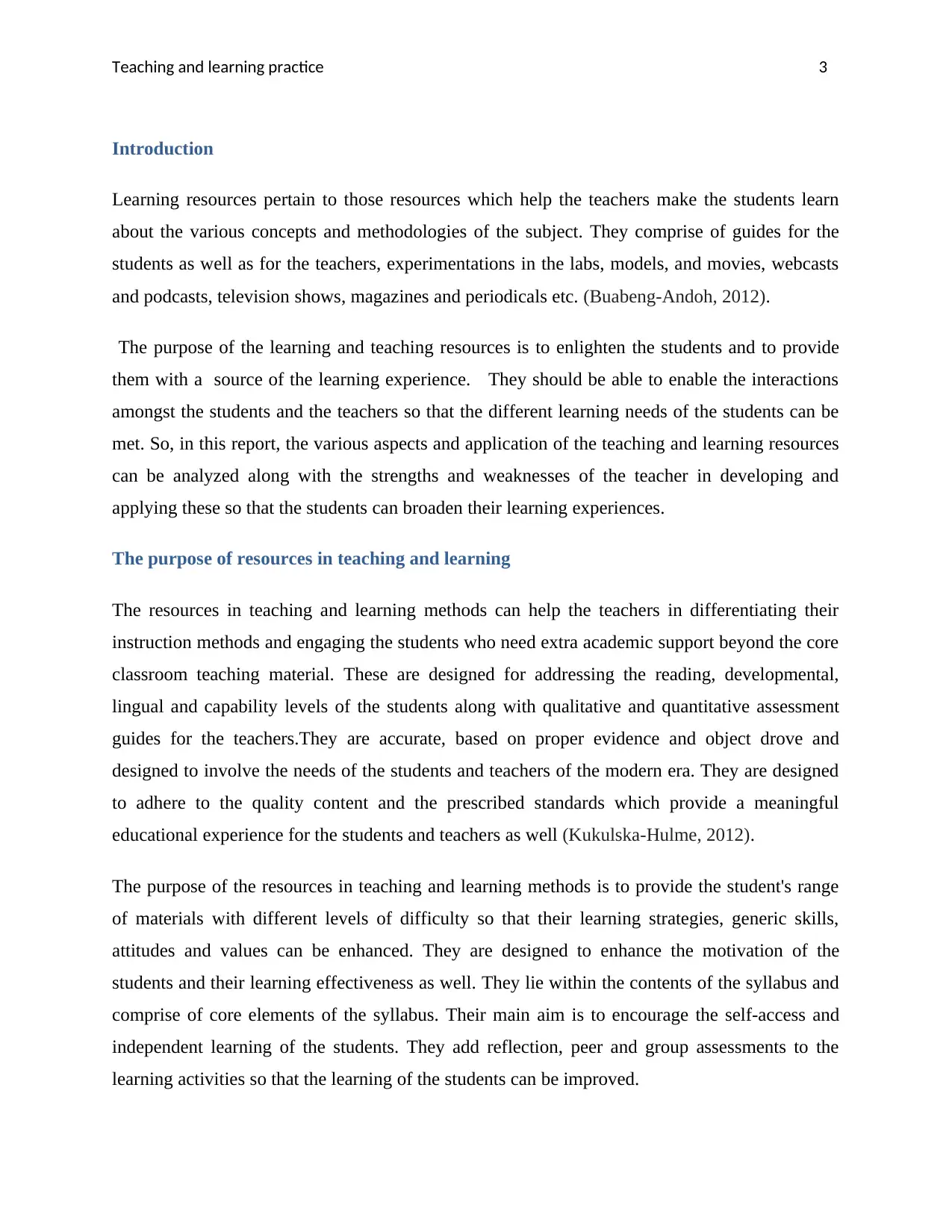
Teaching and learning practice 3
Introduction
Learning resources pertain to those resources which help the teachers make the students learn
about the various concepts and methodologies of the subject. They comprise of guides for the
students as well as for the teachers, experimentations in the labs, models, and movies, webcasts
and podcasts, television shows, magazines and periodicals etc. (Buabeng-Andoh, 2012).
The purpose of the learning and teaching resources is to enlighten the students and to provide
them with a source of the learning experience. They should be able to enable the interactions
amongst the students and the teachers so that the different learning needs of the students can be
met. So, in this report, the various aspects and application of the teaching and learning resources
can be analyzed along with the strengths and weaknesses of the teacher in developing and
applying these so that the students can broaden their learning experiences.
The purpose of resources in teaching and learning
The resources in teaching and learning methods can help the teachers in differentiating their
instruction methods and engaging the students who need extra academic support beyond the core
classroom teaching material. These are designed for addressing the reading, developmental,
lingual and capability levels of the students along with qualitative and quantitative assessment
guides for the teachers.They are accurate, based on proper evidence and object drove and
designed to involve the needs of the students and teachers of the modern era. They are designed
to adhere to the quality content and the prescribed standards which provide a meaningful
educational experience for the students and teachers as well (Kukulska-Hulme, 2012).
The purpose of the resources in teaching and learning methods is to provide the student's range
of materials with different levels of difficulty so that their learning strategies, generic skills,
attitudes and values can be enhanced. They are designed to enhance the motivation of the
students and their learning effectiveness as well. They lie within the contents of the syllabus and
comprise of core elements of the syllabus. Their main aim is to encourage the self-access and
independent learning of the students. They add reflection, peer and group assessments to the
learning activities so that the learning of the students can be improved.
Introduction
Learning resources pertain to those resources which help the teachers make the students learn
about the various concepts and methodologies of the subject. They comprise of guides for the
students as well as for the teachers, experimentations in the labs, models, and movies, webcasts
and podcasts, television shows, magazines and periodicals etc. (Buabeng-Andoh, 2012).
The purpose of the learning and teaching resources is to enlighten the students and to provide
them with a source of the learning experience. They should be able to enable the interactions
amongst the students and the teachers so that the different learning needs of the students can be
met. So, in this report, the various aspects and application of the teaching and learning resources
can be analyzed along with the strengths and weaknesses of the teacher in developing and
applying these so that the students can broaden their learning experiences.
The purpose of resources in teaching and learning
The resources in teaching and learning methods can help the teachers in differentiating their
instruction methods and engaging the students who need extra academic support beyond the core
classroom teaching material. These are designed for addressing the reading, developmental,
lingual and capability levels of the students along with qualitative and quantitative assessment
guides for the teachers.They are accurate, based on proper evidence and object drove and
designed to involve the needs of the students and teachers of the modern era. They are designed
to adhere to the quality content and the prescribed standards which provide a meaningful
educational experience for the students and teachers as well (Kukulska-Hulme, 2012).
The purpose of the resources in teaching and learning methods is to provide the student's range
of materials with different levels of difficulty so that their learning strategies, generic skills,
attitudes and values can be enhanced. They are designed to enhance the motivation of the
students and their learning effectiveness as well. They lie within the contents of the syllabus and
comprise of core elements of the syllabus. Their main aim is to encourage the self-access and
independent learning of the students. They add reflection, peer and group assessments to the
learning activities so that the learning of the students can be improved.
Paraphrase This Document
Need a fresh take? Get an instant paraphrase of this document with our AI Paraphraser
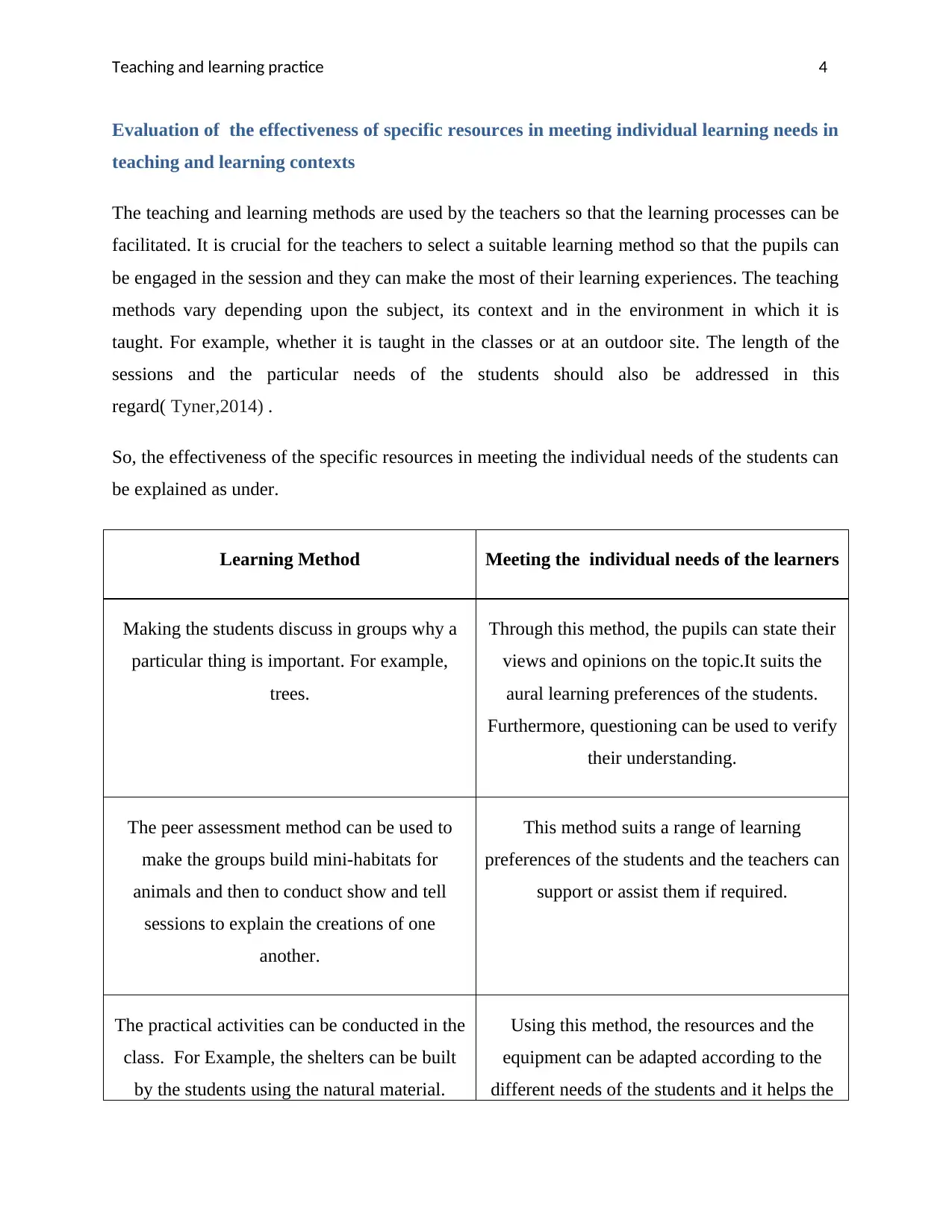
Teaching and learning practice 4
Evaluation of the effectiveness of specific resources in meeting individual learning needs in
teaching and learning contexts
The teaching and learning methods are used by the teachers so that the learning processes can be
facilitated. It is crucial for the teachers to select a suitable learning method so that the pupils can
be engaged in the session and they can make the most of their learning experiences. The teaching
methods vary depending upon the subject, its context and in the environment in which it is
taught. For example, whether it is taught in the classes or at an outdoor site. The length of the
sessions and the particular needs of the students should also be addressed in this
regard( Tyner,2014) .
So, the effectiveness of the specific resources in meeting the individual needs of the students can
be explained as under.
Learning Method Meeting the individual needs of the learners
Making the students discuss in groups why a
particular thing is important. For example,
trees.
Through this method, the pupils can state their
views and opinions on the topic.It suits the
aural learning preferences of the students.
Furthermore, questioning can be used to verify
their understanding.
The peer assessment method can be used to
make the groups build mini-habitats for
animals and then to conduct show and tell
sessions to explain the creations of one
another.
This method suits a range of learning
preferences of the students and the teachers can
support or assist them if required.
The practical activities can be conducted in the
class. For Example, the shelters can be built
by the students using the natural material.
Using this method, the resources and the
equipment can be adapted according to the
different needs of the students and it helps the
Evaluation of the effectiveness of specific resources in meeting individual learning needs in
teaching and learning contexts
The teaching and learning methods are used by the teachers so that the learning processes can be
facilitated. It is crucial for the teachers to select a suitable learning method so that the pupils can
be engaged in the session and they can make the most of their learning experiences. The teaching
methods vary depending upon the subject, its context and in the environment in which it is
taught. For example, whether it is taught in the classes or at an outdoor site. The length of the
sessions and the particular needs of the students should also be addressed in this
regard( Tyner,2014) .
So, the effectiveness of the specific resources in meeting the individual needs of the students can
be explained as under.
Learning Method Meeting the individual needs of the learners
Making the students discuss in groups why a
particular thing is important. For example,
trees.
Through this method, the pupils can state their
views and opinions on the topic.It suits the
aural learning preferences of the students.
Furthermore, questioning can be used to verify
their understanding.
The peer assessment method can be used to
make the groups build mini-habitats for
animals and then to conduct show and tell
sessions to explain the creations of one
another.
This method suits a range of learning
preferences of the students and the teachers can
support or assist them if required.
The practical activities can be conducted in the
class. For Example, the shelters can be built
by the students using the natural material.
Using this method, the resources and the
equipment can be adapted according to the
different needs of the students and it helps the
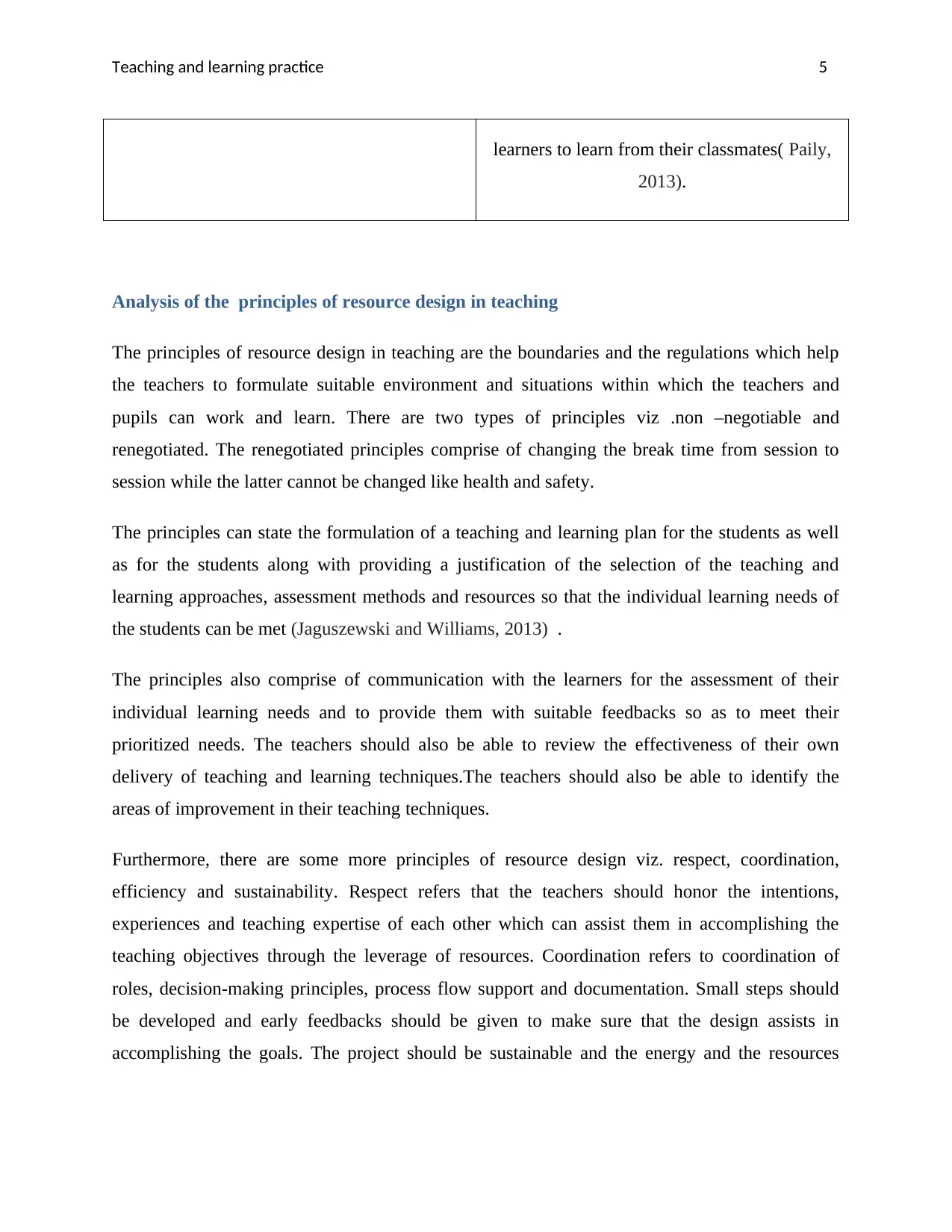
Teaching and learning practice 5
learners to learn from their classmates( Paily,
2013).
Analysis of the principles of resource design in teaching
The principles of resource design in teaching are the boundaries and the regulations which help
the teachers to formulate suitable environment and situations within which the teachers and
pupils can work and learn. There are two types of principles viz .non –negotiable and
renegotiated. The renegotiated principles comprise of changing the break time from session to
session while the latter cannot be changed like health and safety.
The principles can state the formulation of a teaching and learning plan for the students as well
as for the students along with providing a justification of the selection of the teaching and
learning approaches, assessment methods and resources so that the individual learning needs of
the students can be met (Jaguszewski and Williams, 2013) .
The principles also comprise of communication with the learners for the assessment of their
individual learning needs and to provide them with suitable feedbacks so as to meet their
prioritized needs. The teachers should also be able to review the effectiveness of their own
delivery of teaching and learning techniques.The teachers should also be able to identify the
areas of improvement in their teaching techniques.
Furthermore, there are some more principles of resource design viz. respect, coordination,
efficiency and sustainability. Respect refers that the teachers should honor the intentions,
experiences and teaching expertise of each other which can assist them in accomplishing the
teaching objectives through the leverage of resources. Coordination refers to coordination of
roles, decision-making principles, process flow support and documentation. Small steps should
be developed and early feedbacks should be given to make sure that the design assists in
accomplishing the goals. The project should be sustainable and the energy and the resources
learners to learn from their classmates( Paily,
2013).
Analysis of the principles of resource design in teaching
The principles of resource design in teaching are the boundaries and the regulations which help
the teachers to formulate suitable environment and situations within which the teachers and
pupils can work and learn. There are two types of principles viz .non –negotiable and
renegotiated. The renegotiated principles comprise of changing the break time from session to
session while the latter cannot be changed like health and safety.
The principles can state the formulation of a teaching and learning plan for the students as well
as for the students along with providing a justification of the selection of the teaching and
learning approaches, assessment methods and resources so that the individual learning needs of
the students can be met (Jaguszewski and Williams, 2013) .
The principles also comprise of communication with the learners for the assessment of their
individual learning needs and to provide them with suitable feedbacks so as to meet their
prioritized needs. The teachers should also be able to review the effectiveness of their own
delivery of teaching and learning techniques.The teachers should also be able to identify the
areas of improvement in their teaching techniques.
Furthermore, there are some more principles of resource design viz. respect, coordination,
efficiency and sustainability. Respect refers that the teachers should honor the intentions,
experiences and teaching expertise of each other which can assist them in accomplishing the
teaching objectives through the leverage of resources. Coordination refers to coordination of
roles, decision-making principles, process flow support and documentation. Small steps should
be developed and early feedbacks should be given to make sure that the design assists in
accomplishing the goals. The project should be sustainable and the energy and the resources
⊘ This is a preview!⊘
Do you want full access?
Subscribe today to unlock all pages.

Trusted by 1+ million students worldwide
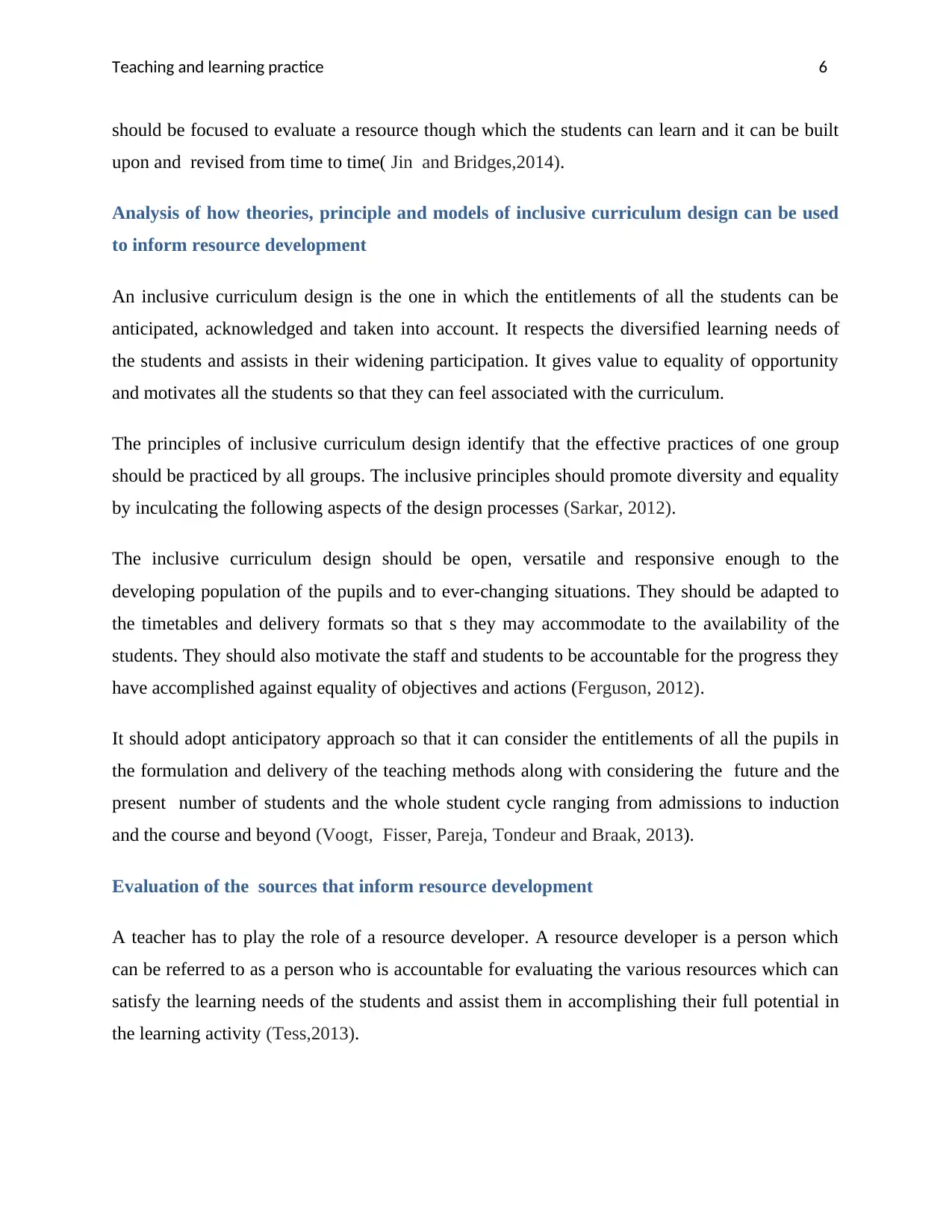
Teaching and learning practice 6
should be focused to evaluate a resource though which the students can learn and it can be built
upon and revised from time to time( Jin and Bridges,2014).
Analysis of how theories, principle and models of inclusive curriculum design can be used
to inform resource development
An inclusive curriculum design is the one in which the entitlements of all the students can be
anticipated, acknowledged and taken into account. It respects the diversified learning needs of
the students and assists in their widening participation. It gives value to equality of opportunity
and motivates all the students so that they can feel associated with the curriculum.
The principles of inclusive curriculum design identify that the effective practices of one group
should be practiced by all groups. The inclusive principles should promote diversity and equality
by inculcating the following aspects of the design processes (Sarkar, 2012).
The inclusive curriculum design should be open, versatile and responsive enough to the
developing population of the pupils and to ever-changing situations. They should be adapted to
the timetables and delivery formats so that s they may accommodate to the availability of the
students. They should also motivate the staff and students to be accountable for the progress they
have accomplished against equality of objectives and actions (Ferguson, 2012).
It should adopt anticipatory approach so that it can consider the entitlements of all the pupils in
the formulation and delivery of the teaching methods along with considering the future and the
present number of students and the whole student cycle ranging from admissions to induction
and the course and beyond (Voogt, Fisser, Pareja, Tondeur and Braak, 2013).
Evaluation of the sources that inform resource development
A teacher has to play the role of a resource developer. A resource developer is a person which
can be referred to as a person who is accountable for evaluating the various resources which can
satisfy the learning needs of the students and assist them in accomplishing their full potential in
the learning activity (Tess,2013).
should be focused to evaluate a resource though which the students can learn and it can be built
upon and revised from time to time( Jin and Bridges,2014).
Analysis of how theories, principle and models of inclusive curriculum design can be used
to inform resource development
An inclusive curriculum design is the one in which the entitlements of all the students can be
anticipated, acknowledged and taken into account. It respects the diversified learning needs of
the students and assists in their widening participation. It gives value to equality of opportunity
and motivates all the students so that they can feel associated with the curriculum.
The principles of inclusive curriculum design identify that the effective practices of one group
should be practiced by all groups. The inclusive principles should promote diversity and equality
by inculcating the following aspects of the design processes (Sarkar, 2012).
The inclusive curriculum design should be open, versatile and responsive enough to the
developing population of the pupils and to ever-changing situations. They should be adapted to
the timetables and delivery formats so that s they may accommodate to the availability of the
students. They should also motivate the staff and students to be accountable for the progress they
have accomplished against equality of objectives and actions (Ferguson, 2012).
It should adopt anticipatory approach so that it can consider the entitlements of all the pupils in
the formulation and delivery of the teaching methods along with considering the future and the
present number of students and the whole student cycle ranging from admissions to induction
and the course and beyond (Voogt, Fisser, Pareja, Tondeur and Braak, 2013).
Evaluation of the sources that inform resource development
A teacher has to play the role of a resource developer. A resource developer is a person which
can be referred to as a person who is accountable for evaluating the various resources which can
satisfy the learning needs of the students and assist them in accomplishing their full potential in
the learning activity (Tess,2013).
Paraphrase This Document
Need a fresh take? Get an instant paraphrase of this document with our AI Paraphraser
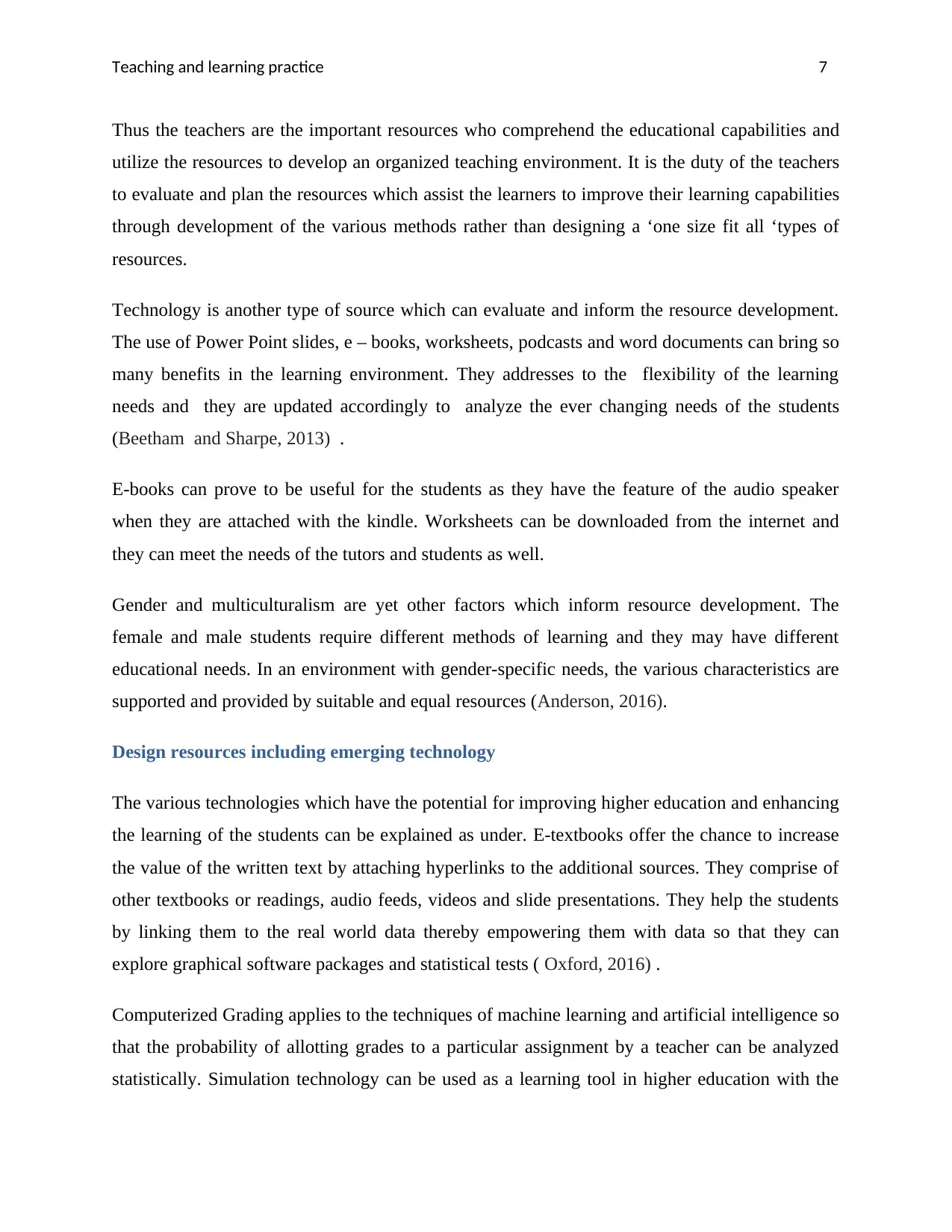
Teaching and learning practice 7
Thus the teachers are the important resources who comprehend the educational capabilities and
utilize the resources to develop an organized teaching environment. It is the duty of the teachers
to evaluate and plan the resources which assist the learners to improve their learning capabilities
through development of the various methods rather than designing a ‘one size fit all ‘types of
resources.
Technology is another type of source which can evaluate and inform the resource development.
The use of Power Point slides, e – books, worksheets, podcasts and word documents can bring so
many benefits in the learning environment. They addresses to the flexibility of the learning
needs and they are updated accordingly to analyze the ever changing needs of the students
(Beetham and Sharpe, 2013) .
E-books can prove to be useful for the students as they have the feature of the audio speaker
when they are attached with the kindle. Worksheets can be downloaded from the internet and
they can meet the needs of the tutors and students as well.
Gender and multiculturalism are yet other factors which inform resource development. The
female and male students require different methods of learning and they may have different
educational needs. In an environment with gender-specific needs, the various characteristics are
supported and provided by suitable and equal resources (Anderson, 2016).
Design resources including emerging technology
The various technologies which have the potential for improving higher education and enhancing
the learning of the students can be explained as under. E-textbooks offer the chance to increase
the value of the written text by attaching hyperlinks to the additional sources. They comprise of
other textbooks or readings, audio feeds, videos and slide presentations. They help the students
by linking them to the real world data thereby empowering them with data so that they can
explore graphical software packages and statistical tests ( Oxford, 2016) .
Computerized Grading applies to the techniques of machine learning and artificial intelligence so
that the probability of allotting grades to a particular assignment by a teacher can be analyzed
statistically. Simulation technology can be used as a learning tool in higher education with the
Thus the teachers are the important resources who comprehend the educational capabilities and
utilize the resources to develop an organized teaching environment. It is the duty of the teachers
to evaluate and plan the resources which assist the learners to improve their learning capabilities
through development of the various methods rather than designing a ‘one size fit all ‘types of
resources.
Technology is another type of source which can evaluate and inform the resource development.
The use of Power Point slides, e – books, worksheets, podcasts and word documents can bring so
many benefits in the learning environment. They addresses to the flexibility of the learning
needs and they are updated accordingly to analyze the ever changing needs of the students
(Beetham and Sharpe, 2013) .
E-books can prove to be useful for the students as they have the feature of the audio speaker
when they are attached with the kindle. Worksheets can be downloaded from the internet and
they can meet the needs of the tutors and students as well.
Gender and multiculturalism are yet other factors which inform resource development. The
female and male students require different methods of learning and they may have different
educational needs. In an environment with gender-specific needs, the various characteristics are
supported and provided by suitable and equal resources (Anderson, 2016).
Design resources including emerging technology
The various technologies which have the potential for improving higher education and enhancing
the learning of the students can be explained as under. E-textbooks offer the chance to increase
the value of the written text by attaching hyperlinks to the additional sources. They comprise of
other textbooks or readings, audio feeds, videos and slide presentations. They help the students
by linking them to the real world data thereby empowering them with data so that they can
explore graphical software packages and statistical tests ( Oxford, 2016) .
Computerized Grading applies to the techniques of machine learning and artificial intelligence so
that the probability of allotting grades to a particular assignment by a teacher can be analyzed
statistically. Simulation technology can be used as a learning tool in higher education with the
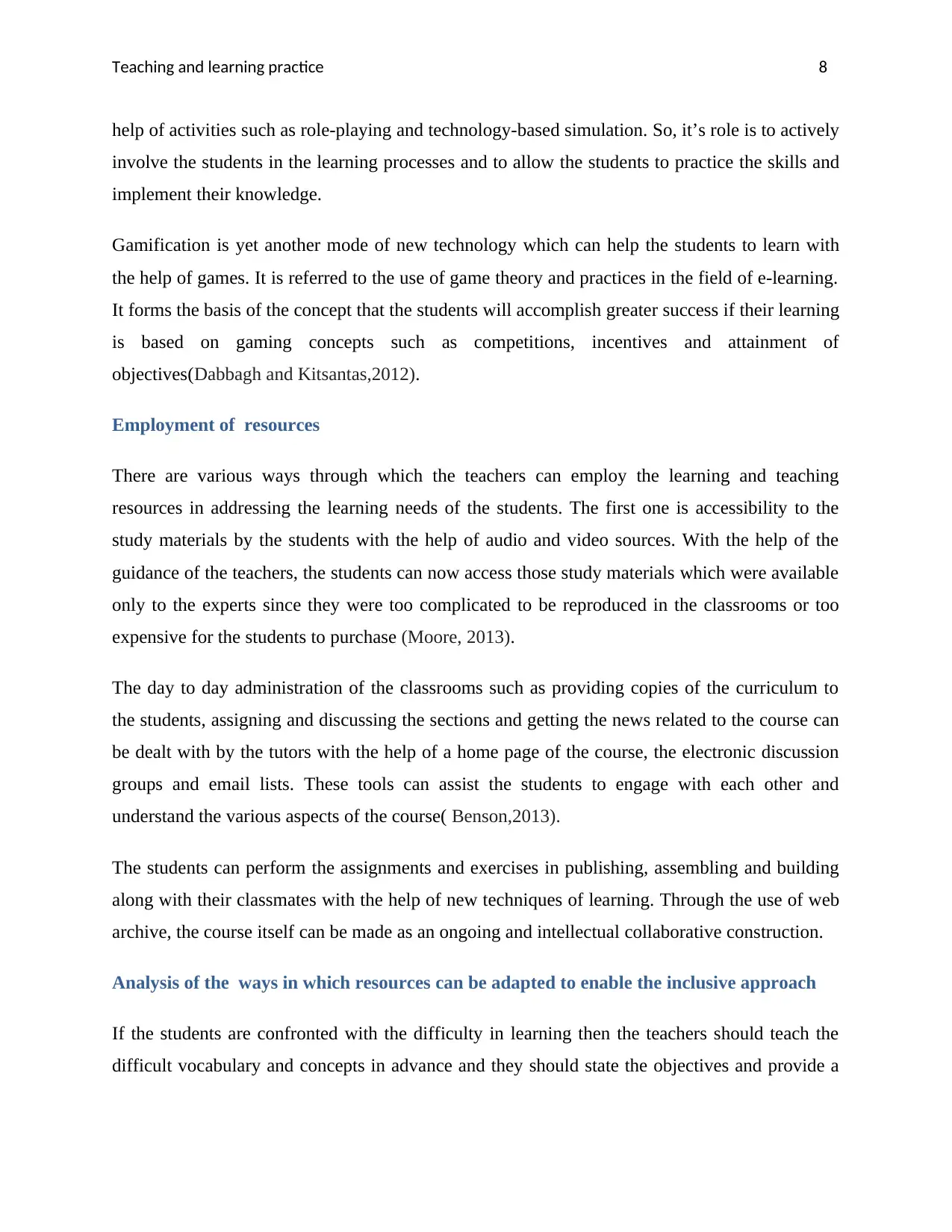
Teaching and learning practice 8
help of activities such as role-playing and technology-based simulation. So, it’s role is to actively
involve the students in the learning processes and to allow the students to practice the skills and
implement their knowledge.
Gamification is yet another mode of new technology which can help the students to learn with
the help of games. It is referred to the use of game theory and practices in the field of e-learning.
It forms the basis of the concept that the students will accomplish greater success if their learning
is based on gaming concepts such as competitions, incentives and attainment of
objectives(Dabbagh and Kitsantas,2012).
Employment of resources
There are various ways through which the teachers can employ the learning and teaching
resources in addressing the learning needs of the students. The first one is accessibility to the
study materials by the students with the help of audio and video sources. With the help of the
guidance of the teachers, the students can now access those study materials which were available
only to the experts since they were too complicated to be reproduced in the classrooms or too
expensive for the students to purchase (Moore, 2013).
The day to day administration of the classrooms such as providing copies of the curriculum to
the students, assigning and discussing the sections and getting the news related to the course can
be dealt with by the tutors with the help of a home page of the course, the electronic discussion
groups and email lists. These tools can assist the students to engage with each other and
understand the various aspects of the course( Benson,2013).
The students can perform the assignments and exercises in publishing, assembling and building
along with their classmates with the help of new techniques of learning. Through the use of web
archive, the course itself can be made as an ongoing and intellectual collaborative construction.
Analysis of the ways in which resources can be adapted to enable the inclusive approach
If the students are confronted with the difficulty in learning then the teachers should teach the
difficult vocabulary and concepts in advance and they should state the objectives and provide a
help of activities such as role-playing and technology-based simulation. So, it’s role is to actively
involve the students in the learning processes and to allow the students to practice the skills and
implement their knowledge.
Gamification is yet another mode of new technology which can help the students to learn with
the help of games. It is referred to the use of game theory and practices in the field of e-learning.
It forms the basis of the concept that the students will accomplish greater success if their learning
is based on gaming concepts such as competitions, incentives and attainment of
objectives(Dabbagh and Kitsantas,2012).
Employment of resources
There are various ways through which the teachers can employ the learning and teaching
resources in addressing the learning needs of the students. The first one is accessibility to the
study materials by the students with the help of audio and video sources. With the help of the
guidance of the teachers, the students can now access those study materials which were available
only to the experts since they were too complicated to be reproduced in the classrooms or too
expensive for the students to purchase (Moore, 2013).
The day to day administration of the classrooms such as providing copies of the curriculum to
the students, assigning and discussing the sections and getting the news related to the course can
be dealt with by the tutors with the help of a home page of the course, the electronic discussion
groups and email lists. These tools can assist the students to engage with each other and
understand the various aspects of the course( Benson,2013).
The students can perform the assignments and exercises in publishing, assembling and building
along with their classmates with the help of new techniques of learning. Through the use of web
archive, the course itself can be made as an ongoing and intellectual collaborative construction.
Analysis of the ways in which resources can be adapted to enable the inclusive approach
If the students are confronted with the difficulty in learning then the teachers should teach the
difficult vocabulary and concepts in advance and they should state the objectives and provide a
⊘ This is a preview!⊘
Do you want full access?
Subscribe today to unlock all pages.

Trusted by 1+ million students worldwide
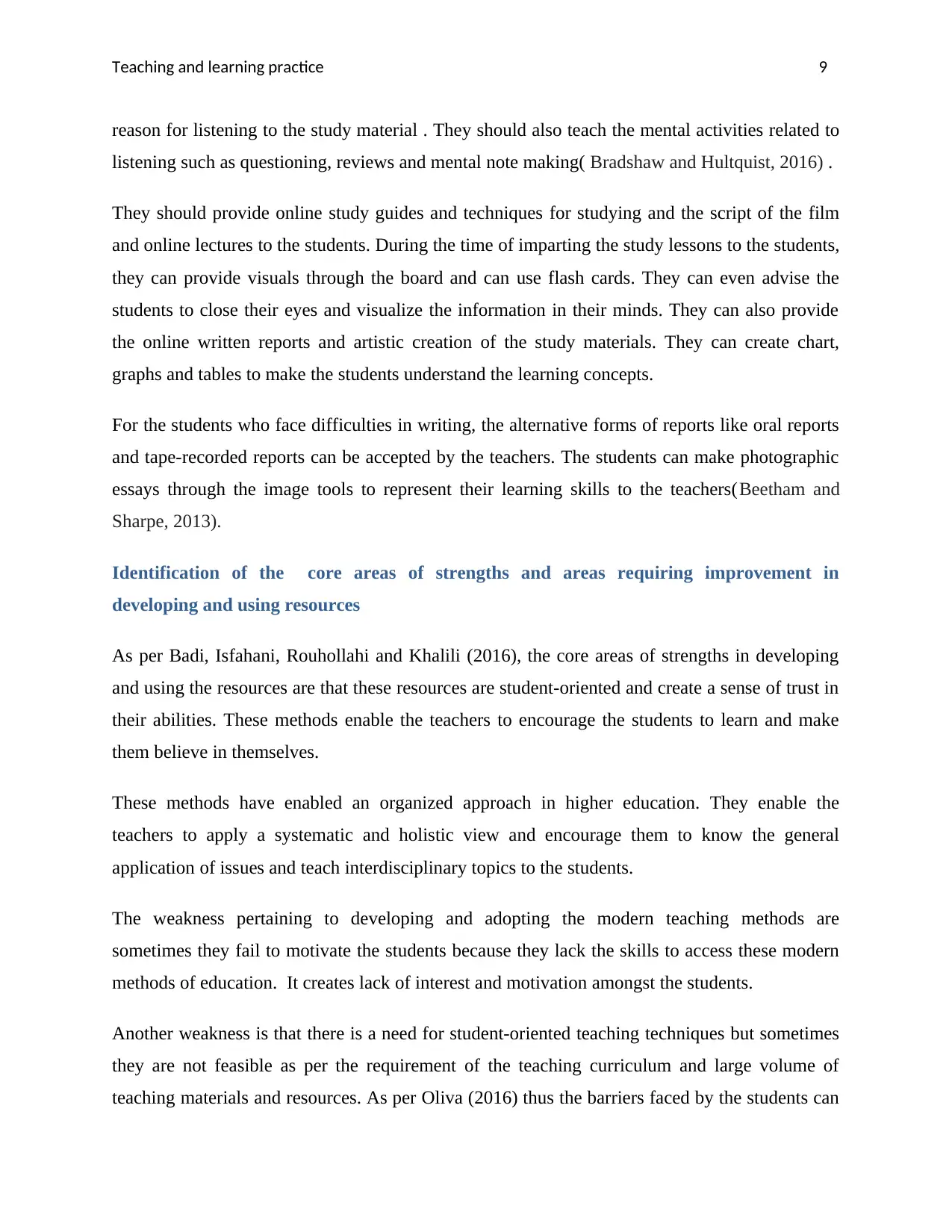
Teaching and learning practice 9
reason for listening to the study material . They should also teach the mental activities related to
listening such as questioning, reviews and mental note making( Bradshaw and Hultquist, 2016) .
They should provide online study guides and techniques for studying and the script of the film
and online lectures to the students. During the time of imparting the study lessons to the students,
they can provide visuals through the board and can use flash cards. They can even advise the
students to close their eyes and visualize the information in their minds. They can also provide
the online written reports and artistic creation of the study materials. They can create chart,
graphs and tables to make the students understand the learning concepts.
For the students who face difficulties in writing, the alternative forms of reports like oral reports
and tape-recorded reports can be accepted by the teachers. The students can make photographic
essays through the image tools to represent their learning skills to the teachers(Beetham and
Sharpe, 2013).
Identification of the core areas of strengths and areas requiring improvement in
developing and using resources
As per Badi, Isfahani, Rouhollahi and Khalili (2016), the core areas of strengths in developing
and using the resources are that these resources are student-oriented and create a sense of trust in
their abilities. These methods enable the teachers to encourage the students to learn and make
them believe in themselves.
These methods have enabled an organized approach in higher education. They enable the
teachers to apply a systematic and holistic view and encourage them to know the general
application of issues and teach interdisciplinary topics to the students.
The weakness pertaining to developing and adopting the modern teaching methods are
sometimes they fail to motivate the students because they lack the skills to access these modern
methods of education. It creates lack of interest and motivation amongst the students.
Another weakness is that there is a need for student-oriented teaching techniques but sometimes
they are not feasible as per the requirement of the teaching curriculum and large volume of
teaching materials and resources. As per Oliva (2016) thus the barriers faced by the students can
reason for listening to the study material . They should also teach the mental activities related to
listening such as questioning, reviews and mental note making( Bradshaw and Hultquist, 2016) .
They should provide online study guides and techniques for studying and the script of the film
and online lectures to the students. During the time of imparting the study lessons to the students,
they can provide visuals through the board and can use flash cards. They can even advise the
students to close their eyes and visualize the information in their minds. They can also provide
the online written reports and artistic creation of the study materials. They can create chart,
graphs and tables to make the students understand the learning concepts.
For the students who face difficulties in writing, the alternative forms of reports like oral reports
and tape-recorded reports can be accepted by the teachers. The students can make photographic
essays through the image tools to represent their learning skills to the teachers(Beetham and
Sharpe, 2013).
Identification of the core areas of strengths and areas requiring improvement in
developing and using resources
As per Badi, Isfahani, Rouhollahi and Khalili (2016), the core areas of strengths in developing
and using the resources are that these resources are student-oriented and create a sense of trust in
their abilities. These methods enable the teachers to encourage the students to learn and make
them believe in themselves.
These methods have enabled an organized approach in higher education. They enable the
teachers to apply a systematic and holistic view and encourage them to know the general
application of issues and teach interdisciplinary topics to the students.
The weakness pertaining to developing and adopting the modern teaching methods are
sometimes they fail to motivate the students because they lack the skills to access these modern
methods of education. It creates lack of interest and motivation amongst the students.
Another weakness is that there is a need for student-oriented teaching techniques but sometimes
they are not feasible as per the requirement of the teaching curriculum and large volume of
teaching materials and resources. As per Oliva (2016) thus the barriers faced by the students can
Paraphrase This Document
Need a fresh take? Get an instant paraphrase of this document with our AI Paraphraser
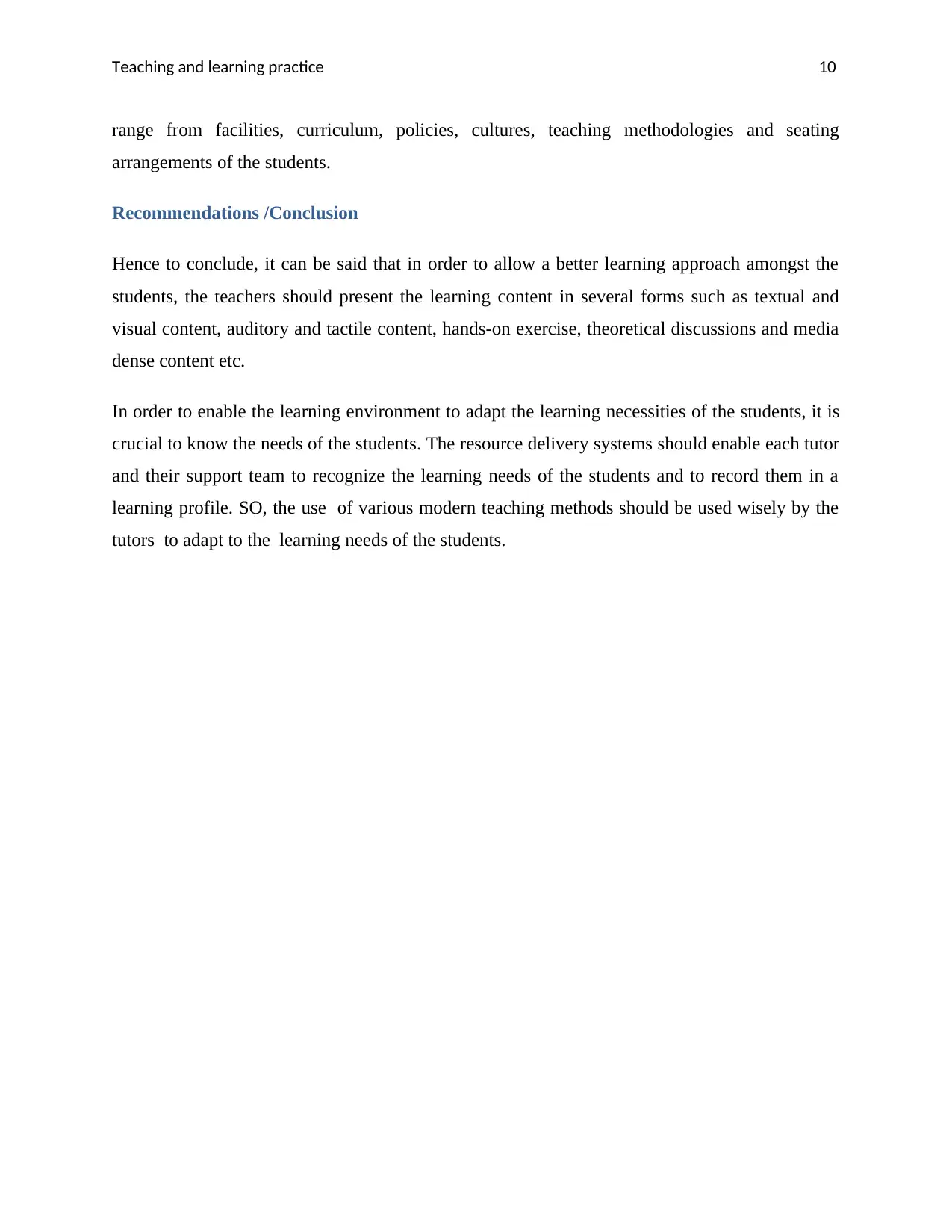
Teaching and learning practice 10
range from facilities, curriculum, policies, cultures, teaching methodologies and seating
arrangements of the students.
Recommendations /Conclusion
Hence to conclude, it can be said that in order to allow a better learning approach amongst the
students, the teachers should present the learning content in several forms such as textual and
visual content, auditory and tactile content, hands-on exercise, theoretical discussions and media
dense content etc.
In order to enable the learning environment to adapt the learning necessities of the students, it is
crucial to know the needs of the students. The resource delivery systems should enable each tutor
and their support team to recognize the learning needs of the students and to record them in a
learning profile. SO, the use of various modern teaching methods should be used wisely by the
tutors to adapt to the learning needs of the students.
range from facilities, curriculum, policies, cultures, teaching methodologies and seating
arrangements of the students.
Recommendations /Conclusion
Hence to conclude, it can be said that in order to allow a better learning approach amongst the
students, the teachers should present the learning content in several forms such as textual and
visual content, auditory and tactile content, hands-on exercise, theoretical discussions and media
dense content etc.
In order to enable the learning environment to adapt the learning necessities of the students, it is
crucial to know the needs of the students. The resource delivery systems should enable each tutor
and their support team to recognize the learning needs of the students and to record them in a
learning profile. SO, the use of various modern teaching methods should be used wisely by the
tutors to adapt to the learning needs of the students.
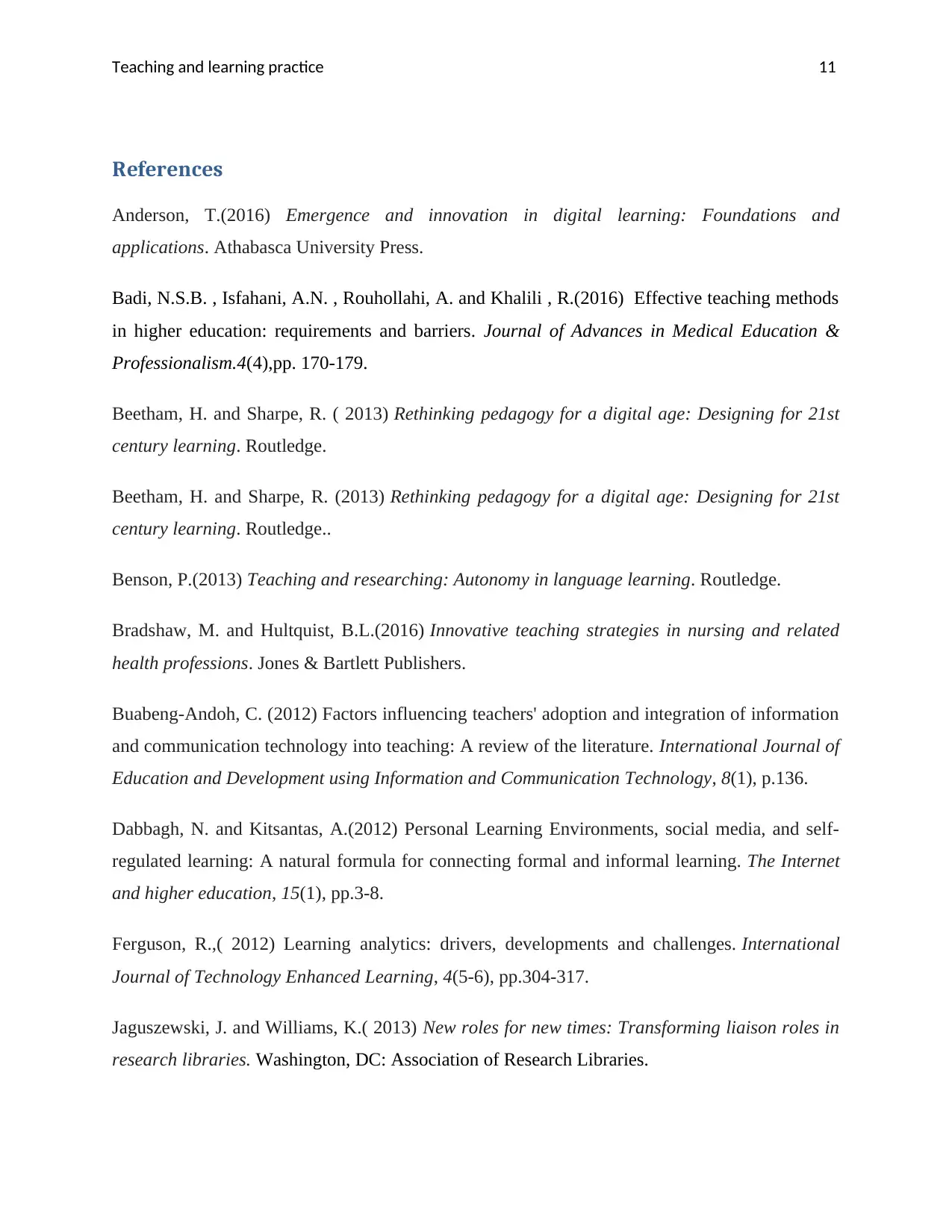
Teaching and learning practice 11
References
Anderson, T.(2016) Emergence and innovation in digital learning: Foundations and
applications. Athabasca University Press.
Badi, N.S.B. , Isfahani, A.N. , Rouhollahi, A. and Khalili , R.(2016) Effective teaching methods
in higher education: requirements and barriers. Journal of Advances in Medical Education &
Professionalism.4(4),pp. 170-179.
Beetham, H. and Sharpe, R. ( 2013) Rethinking pedagogy for a digital age: Designing for 21st
century learning. Routledge.
Beetham, H. and Sharpe, R. (2013) Rethinking pedagogy for a digital age: Designing for 21st
century learning. Routledge..
Benson, P.(2013) Teaching and researching: Autonomy in language learning. Routledge.
Bradshaw, M. and Hultquist, B.L.(2016) Innovative teaching strategies in nursing and related
health professions. Jones & Bartlett Publishers.
Buabeng-Andoh, C. (2012) Factors influencing teachers' adoption and integration of information
and communication technology into teaching: A review of the literature. International Journal of
Education and Development using Information and Communication Technology, 8(1), p.136.
Dabbagh, N. and Kitsantas, A.(2012) Personal Learning Environments, social media, and self-
regulated learning: A natural formula for connecting formal and informal learning. The Internet
and higher education, 15(1), pp.3-8.
Ferguson, R.,( 2012) Learning analytics: drivers, developments and challenges. International
Journal of Technology Enhanced Learning, 4(5-6), pp.304-317.
Jaguszewski, J. and Williams, K.( 2013) New roles for new times: Transforming liaison roles in
research libraries. Washington, DC: Association of Research Libraries.
References
Anderson, T.(2016) Emergence and innovation in digital learning: Foundations and
applications. Athabasca University Press.
Badi, N.S.B. , Isfahani, A.N. , Rouhollahi, A. and Khalili , R.(2016) Effective teaching methods
in higher education: requirements and barriers. Journal of Advances in Medical Education &
Professionalism.4(4),pp. 170-179.
Beetham, H. and Sharpe, R. ( 2013) Rethinking pedagogy for a digital age: Designing for 21st
century learning. Routledge.
Beetham, H. and Sharpe, R. (2013) Rethinking pedagogy for a digital age: Designing for 21st
century learning. Routledge..
Benson, P.(2013) Teaching and researching: Autonomy in language learning. Routledge.
Bradshaw, M. and Hultquist, B.L.(2016) Innovative teaching strategies in nursing and related
health professions. Jones & Bartlett Publishers.
Buabeng-Andoh, C. (2012) Factors influencing teachers' adoption and integration of information
and communication technology into teaching: A review of the literature. International Journal of
Education and Development using Information and Communication Technology, 8(1), p.136.
Dabbagh, N. and Kitsantas, A.(2012) Personal Learning Environments, social media, and self-
regulated learning: A natural formula for connecting formal and informal learning. The Internet
and higher education, 15(1), pp.3-8.
Ferguson, R.,( 2012) Learning analytics: drivers, developments and challenges. International
Journal of Technology Enhanced Learning, 4(5-6), pp.304-317.
Jaguszewski, J. and Williams, K.( 2013) New roles for new times: Transforming liaison roles in
research libraries. Washington, DC: Association of Research Libraries.
⊘ This is a preview!⊘
Do you want full access?
Subscribe today to unlock all pages.

Trusted by 1+ million students worldwide
1 out of 13
Related Documents
Your All-in-One AI-Powered Toolkit for Academic Success.
+13062052269
info@desklib.com
Available 24*7 on WhatsApp / Email
![[object Object]](/_next/static/media/star-bottom.7253800d.svg)
Unlock your academic potential
Copyright © 2020–2025 A2Z Services. All Rights Reserved. Developed and managed by ZUCOL.


